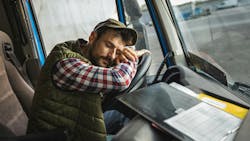Samsara’s AI-powered drowsiness detection now generally available
Samsara recently released its Drowsiness Detection feature to its customers worldwide. Drowsiness Detection uses Samsara’s comprehensive AI models—trained on its large-scale dataset—to detect signs of drowsiness. The systen then triggers real-time in-cab audio alerts for drivers while notifying managers via text or email to triage fatigue-related events as they occur. These insights can be viewed as aggregated reports within the Samsara Platform, allowing managers to analyze patterns of fatigue across their fleet, focus on driver coaching, and reduce drowsy driving to improve road safety.
The National Safety Council reports that drivers are three times more likely to be in a crash if they are fatigued, and according to the AAA Foundation for Traffic Safety, more than 17% of all fatal crashes involve a drowsy driver. In the commercial trucking industry, drivers are even more at risk given long hours and unpredictable road conditions. That’s why preventing drowsiness is a top priority for Samsara’s tens of thousands of customers.
“It’s hard to detect when someone is truly drowsy,” Evan Welbourne, VP of AI and data at Samsara, said. “It’s more than a single behavior, like yawning or having your eyes closed. Drowsiness can be less common than other risky driving behaviors, so accurate detection is only as good as the data that feeds and trains AI models. That’s where the scale of Samsara’s data sets our solution apart. We train our models on more than 38 billion minutes of video footage within our platform to provide high accuracy and impact for our customers.”
See also: Refrigerated fleet grows with Samsara tech
Samsara says its Drowsiness Detection feature is trained to consider several behaviors that indicate fatigue, in alignment with clinically validated standards for defining drowsiness. These behaviors include head nodding, slouching, prolonged eye closure, yawning, rubbing eyes, and more.
Samsara first announced Drowsiness Detection at its 2024 Beyond conference in June. Since then, customers have already experienced an impact. For example, Samsara reported that one of the largest oil field services companies in the U.S. has seen a significant decrease in how often drivers fall asleep during shifts since using its Drowsiness Detection. According to their VP of health, safety, and environment, “We used to have multiple drivers falling asleep at the wheel. Now, we've gone as long as 30 days without a single driver falling asleep due to these alerts.”
About the Author
FleetOwner Staff
Our Editorial Team
Kevin Jones, Editorial Director, Commercial Vehicle Group
Josh Fisher, Editor-in-Chief
Jade Brasher, Senior Editor
Jeremy Wolfe, Editor
Jenna Hume, Digital Editor
Eric Van Egeren, Art Director
